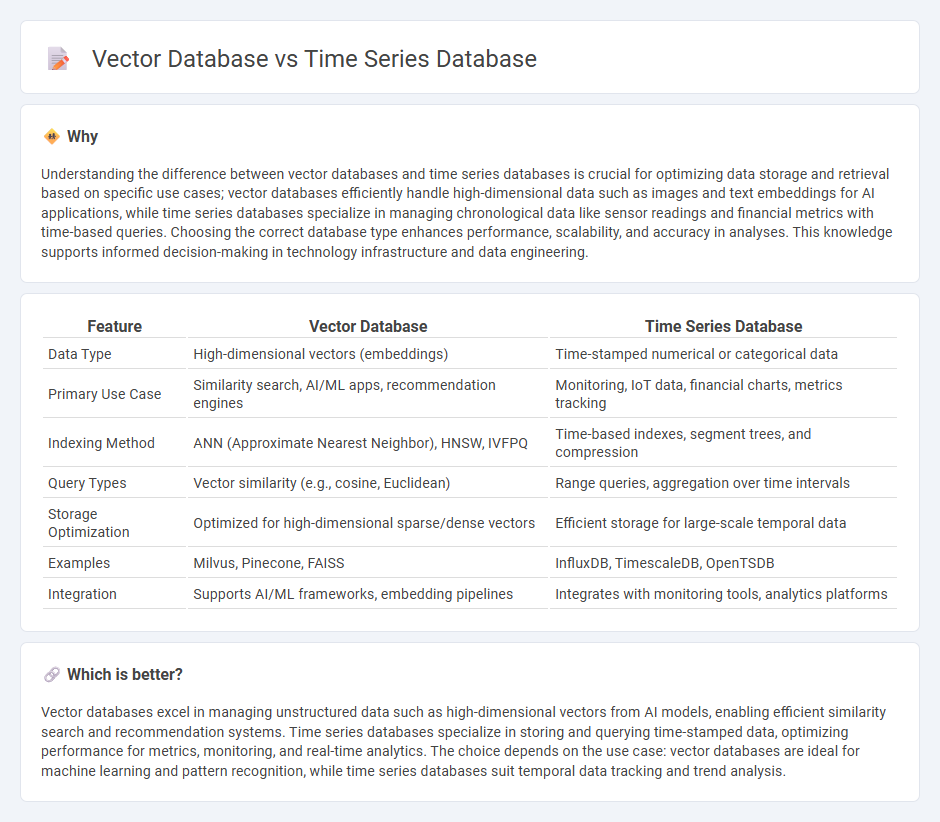
Vector databases specialize in storing and querying high-dimensional data such as embeddings used in machine learning and AI applications, enabling efficient similarity searches across complex datasets. Time series databases focus on handling sequential, timestamped data with optimized storage and retrieval mechanisms to analyze trends, patterns, and anomalies over time. Explore the differences in architecture, use cases, and performance to understand which database technology best suits your data needs.
Why it is important
Understanding the difference between vector databases and time series databases is crucial for optimizing data storage and retrieval based on specific use cases; vector databases efficiently handle high-dimensional data such as images and text embeddings for AI applications, while time series databases specialize in managing chronological data like sensor readings and financial metrics with time-based queries. Choosing the correct database type enhances performance, scalability, and accuracy in analyses. This knowledge supports informed decision-making in technology infrastructure and data engineering.
Comparison Table
| Feature | Vector Database | Time Series Database |
|---|---|---|
| Data Type | High-dimensional vectors (embeddings) | Time-stamped numerical or categorical data |
| Primary Use Case | Similarity search, AI/ML apps, recommendation engines | Monitoring, IoT data, financial charts, metrics tracking |
| Indexing Method | ANN (Approximate Nearest Neighbor), HNSW, IVFPQ | Time-based indexes, segment trees, and compression |
| Query Types | Vector similarity (e.g., cosine, Euclidean) | Range queries, aggregation over time intervals |
| Storage Optimization | Optimized for high-dimensional sparse/dense vectors | Efficient storage for large-scale temporal data |
| Examples | Milvus, Pinecone, FAISS | InfluxDB, TimescaleDB, OpenTSDB |
| Integration | Supports AI/ML frameworks, embedding pipelines | Integrates with monitoring tools, analytics platforms |
Which is better?
Vector databases excel in managing unstructured data such as high-dimensional vectors from AI models, enabling efficient similarity search and recommendation systems. Time series databases specialize in storing and querying time-stamped data, optimizing performance for metrics, monitoring, and real-time analytics. The choice depends on the use case: vector databases are ideal for machine learning and pattern recognition, while time series databases suit temporal data tracking and trend analysis.
Connection
Vector databases and time series databases intersect through their ability to efficiently handle large-scale, high-dimensional data generated over time, such as sensor readings or user behavior metrics. Vector databases excel at similarity search in machine learning applications by indexing multi-dimensional vectors representing data points, while time series databases specialize in storing and querying chronological sequences optimized for rapid ingestion and time-based analysis. Integrating vector search capabilities within time series databases enhances anomaly detection, trend forecasting, and real-time data insights by merging temporal patterns with multidimensional feature representations.
Key Terms
Temporal Data vs. Embedding Space
Time series databases specialize in storing and querying temporal data efficiently, enabling analysis of trends, patterns, and anomalies over time. Vector databases optimize storage and retrieval of high-dimensional embedding vectors, enhancing similarity search in machine learning and AI applications. Explore the unique advantages and use cases of temporal data and embedding space management to choose the best solution for your needs.
Time-Stamped Indexing vs. High-Dimensional Indexing
Time series databases specialize in time-stamped indexing, efficiently managing and querying sequences of data points ordered by time to enable precise temporal analysis and trend detection. Vector databases excel in high-dimensional indexing, allowing for rapid similarity searches and retrieval of complex data representations like embeddings used in AI and machine learning applications. Explore the distinctive advantages of each database type to optimize your data strategy.
Aggregation Queries vs. Similarity Search
Time series databases excel in handling aggregation queries by efficiently summarizing large volumes of sequential data through operations like averages, sums, and moving averages over time intervals. Vector databases specialize in similarity search by indexing high-dimensional vectors to quickly retrieve data points based on proximity and pattern matching using algorithms like nearest neighbor search. Explore detailed comparisons and use cases to better understand which database type aligns with your analytical needs.
Source and External Links
What Is A Time Series Database? How It Works & Use Cases - A time-series database (TSDB) is designed to efficiently store and retrieve data points indexed by timestamps, supporting high-speed insertion and retrieval for time-ordered data used in complex analysis like sensor readings or stock prices.
Time Series Database (TSDB): A Guide With Examples - TSDBs are optimized for high-ingestion rates of timestamped data, efficient queries over time intervals, and use time-based partitioning and aggregation techniques for analytics like rolling averages.
Time series database - A time series database is optimized to handle large, uniform datasets composed of timestamps and values, employing compression and specialized indexing to improve performance and enable data downsampling or deletion of old data.
 dowidth.com
dowidth.com